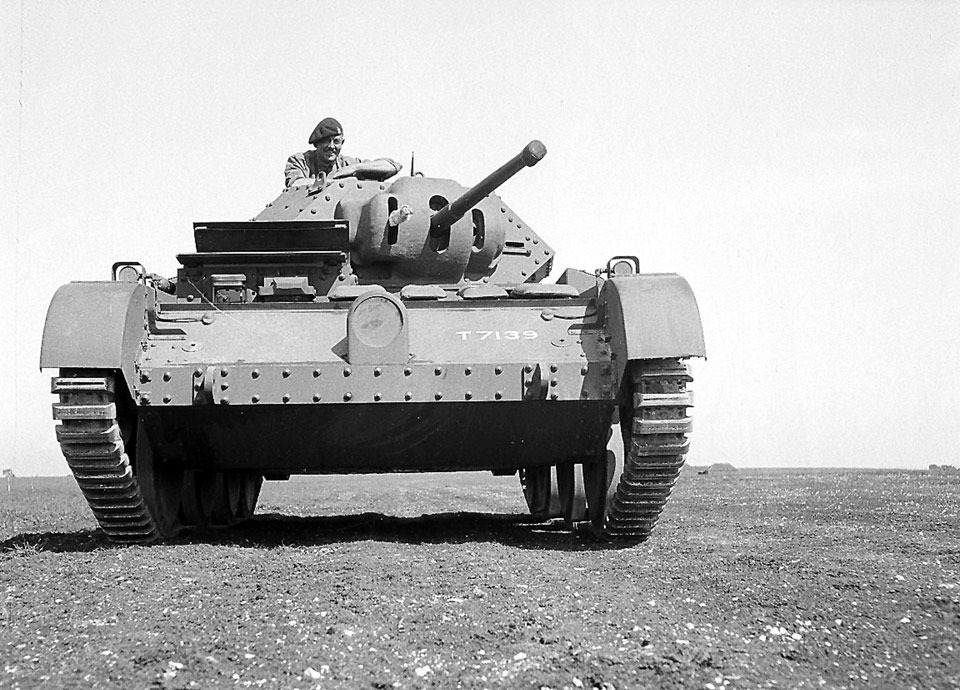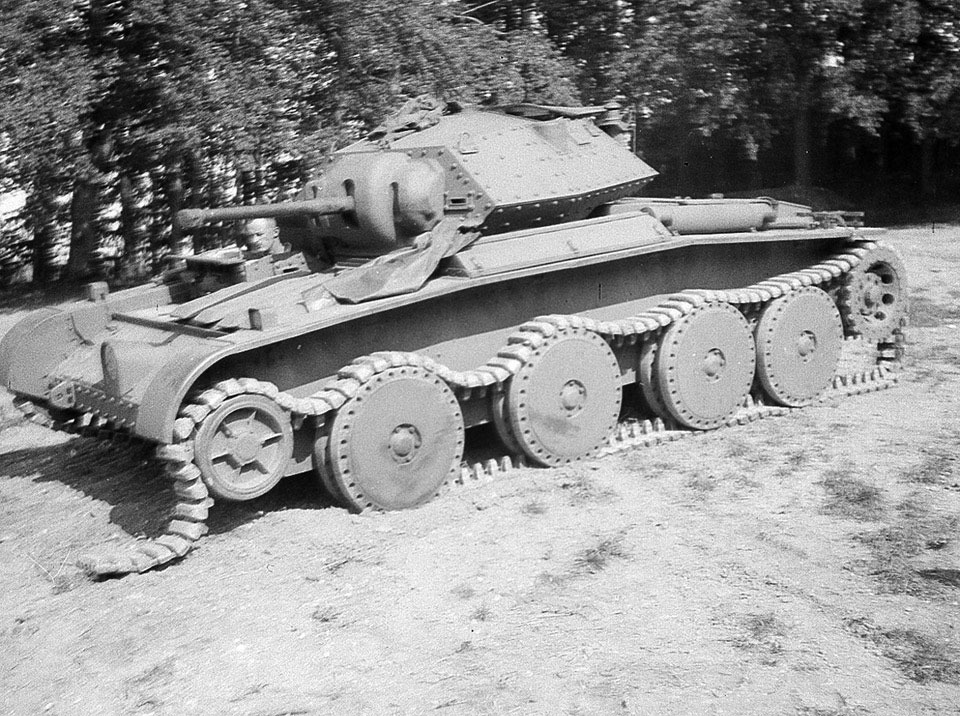- Yes
- No
Tank, Cruiser, Mk V, Covenanter (A13 Mk III)
Vehicle design and service history:
The Cruiser Tank MK V, also known as the A13 MK III Covenanter was one of the many British cruiser tanks that would be developed and see service during the Second World War, along with the first one that would receive a name outside of its normal service designation; that of the Covenanters, a Scottish religious faction at the time of the Wars of the Three Kingdoms. The Covenanter was designed by the London, Midland and Scottish Railway with the intention of creating a better-armoured replacement for the Cruiser Mk IV that was in service at the time, and it was ordered into production in 1929 before a pilot model was even completed. This predictably led to problems with the design that would only become apparent only after production was underway.
Despite setbacks with the design, the Tank would still be used to equip numerous British armoured divisions for both home defence and training, even if it would never leave the home islands in any real capacity due to its poor engine cooling which rendered it unfit for service oversea, especially those with hot environments like North Africa. This would eventually be rectified by the MK IV, after countless corrective actions were applied to the design, but by then it was February of 1944 and the vehicle had already been deemed obsolete. Regardless of the technical issues, more than 1,700 vehicles of this type were made before production concluded.
The story of the Covenanter begins in 1938, when the War Office issued a requirement for a new and more heavily armed “Heavy” cruiser tank to replace the Cruiser MK IV. Nuffield’s proposal the A16 was found to be too expensive, resulting in the cheaper and lighter A13 MK III being selected for development. The name was more the product of General Staff specification though, as aside from the Christie suspension and armament the design had little in common with the other A13 specifications.
The initial specification called for a QF 2-pounder gun, along with at least one machine gun, along with the same A13 Christie suspension, in a lower full. This was combined with an Epicyclic steering transmission along with an armour standard of 30mm at a minimum. This request meant that any vertical plate had to be at least 30mm (1.2inches) thick. This specification also allowed for sloped armour to be thinner, but only if it was at least as effective as a 30mm thick section of vertical plate.
In order to take advantage of this change and save weight, the design included as many sloped surfaces as possible, in order to reduce the overall weight of the vehicle. This was combined with a cranked arms suspension and low-profile engine, in order to produce the shortest silhouette possible. This low-profile engine resulted in the production of an engine specifically designed for the tank, that was required to deliver at least 300 horsepower (220 kW). This engine is connected to a Wilson transmission, and the repurposed steering was used in the A16 design in order to save on development time.
Design work was started by the London, Midland and Scottish Railway Company (LMS), who like several manufacturers of Tanks at the time had no prior experience in the design and production of armoured fighting vehicles. This was due to the government policy that British companies should be developing valuable skills in the expectation of a possible war with Germany, which was in the process of remilitarizing. This lack of previous experience resulted in a design using a welded hull rather than the norm of riveting. Not all the design was done by LMS though, and the turret was designed by Nuffield, whilst Henry Medows produced the new low-profile engines. Confident in the design, the War Office ordered an initial run of 100 vehicles from LMS on the 17th of April 1939, before a prototype had even been produced. Additional orders would soon follow, with English Electric and Leyland Motors, for what would eventually total a final production run of 1,771 vehicles. Nuffield would also be approached, but they preferred their own design, which would ultimately be the more successful MK.VI Crusader.
This expedited order was due to the looming expectation of war, which resulted in the design being ordered off the drawing board, with the expectation that two pilot models could be made to serve for testing and then the improvements gleamed from their trials could be used to improve the production model. In order to meet the pressing engine requirements, a horizontally opposed 12-cylinder design was used. This engine was flat, but very wide, leaving no space for the radiators in the engine compartment, resulting in them being located at the front of the vehicle. This odd configuration would cause no end of trouble, as though it seemed fine when tested on the mock-up when combined with the rushed design resulting in horrendous engine cooling characteristics. This resulted in the system being redesigned multiple times, but these problems persisted, including the added issue of piping from the engine to the radiators heating the fighting compartment during operation. This would make the hotboxing vehicle entirely unsuitable for service in the North African Campaign, and instead it at home and its role fulfilled by Crusader and American tanks.
LMS also asked for a return to riveted construction, as they doubted the quality and strength of the welds used, and instead of further risking delays in production due to a lack of welders the request was accepted. The initial welded design used two layers of interlocked plates, allowing the inner steel to be welded without losing its strength and other protective properties. This two-plate design was retained with the new riveted construction, though the initial plans to use aluminium road wheels were rejected and these would instead be made of steel. In addition, the armour specification for the front hull and the turret was increased to 40mm (1.6in), this change pushed the design to the max load of the suspension, effectively leaving no room for further development of the design if upgunning became required. A final rushed change was the addition of the A13 gearbox over the intended design, necessitating a reduced size of the cooling fan in the transmission compartment.
With this modified design contracts were placed in 1939, and a pilot model with a welded hull was tested with favourable outcomes in 1940. This would be a false positive though, as the second pilot suffered profusely from overheating issues that would be a running theme once the first deliveries of production vehicles began. The Covenanter would miss the start of the war, with the first vehicles reaching units just after the battle of Dunkirk, due to production turrets lagging behind the of hulls, ironically resulting in production of the type continuing well after better tank designs were waiting for space on the production lines.
With the tooling in place though production continued, and by late 1943 the Covenanter was considered both too weakly armed and armoured to be of any use against German armour then in service, and no corrections could be made without significant modification and changes to the design resulting in the tanks being declared obsolete, with all variants other than the versatile bridge layer derivative to be scrapped. Despite this the Covenanter would see a wide range of training and home defence service, for example being used to re-equip the 1st Armoured Division after they lost the majority of their tanks during the Fall of France. These tanks would not stay with the unit long though, and by the time the 1st were sent to Egypt the Covenanters had been transferred to the 9th Armoured Division so the 1st could use the more suitable Crusader tanks. This would be a repeating theme, and only a few trial Covenanters would ever see service overseas when a small handful of tanks were sent to the desert for service trials with the REME, marking the end of a rather muted career for a mass-produced but unsuitable for service cruiser tank…
Vehicle specification:
Mass 18 long tons (18 t)
Length 19 ft 0 in (5.79 m)
Width 8 ft 7 in (2.62 m)
Height 7 ft 4 in (2.24 m)
Crew 4 (commander, gunner, loader, driver)
Armour 7–40 mm (0.28–1.57 in)
Main armament QF 2-pounder (40 mm)
Secondary armament 7.92 mm Besa machine gun (coaxial)
Engine Meadows D.A.V flat-12 340 hp (250 kW)
Power/weight 18.6 hp (13.9 kW) / tonne
Transmission Meadows gearbox with Wilson epicyclic steering
Suspension Christie
Fuel capacity 92 imperial gallons (420 L)
Operational range 100 mi (160 km)
Maximum speed 30 mph (48 km/h)
Additional historical photos:










Sources:
- Covenanter tank - Wikipedia (Wiki page for the tank)
- Panzerserra Bunker- Military Scale Models in 1/35 scale: junho 2012 (Additional info showing how it slots into the cruiser tank family)
- Tank Archives: Covenanter: Reservist Tank (Additional history and photos)
- https://www.warhistoryonline.com/tanks/covenanter-tank.html (Additional history and photos)



